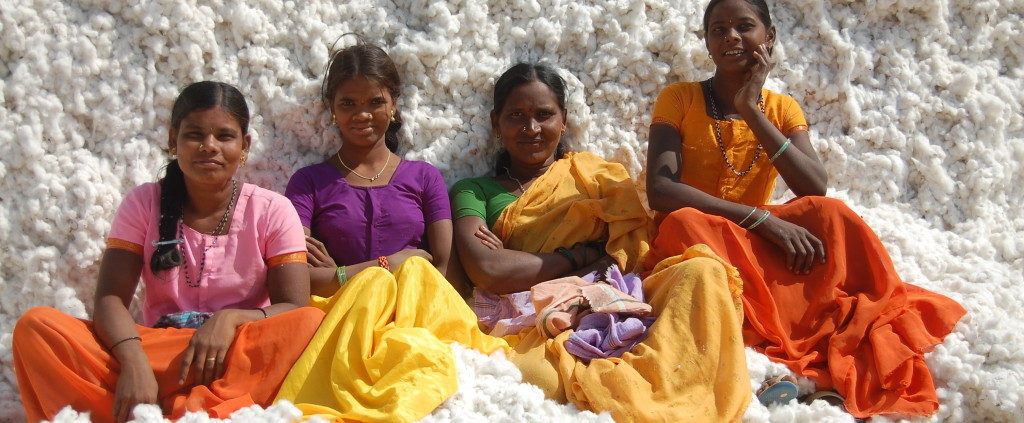
The cotton production process – from field to fabric
Cotton is a shrubby plant that is a member of the Mallow family. It is noted for its versatility, appearance, performance and above all, its natural comfort. From all types of apparel, including astronauts’ in-flight space suits, to sheets and towels, and tarpaulins and tents, cotton in today’s fast-moving world is still nature’s wonder fibre! It provides thousands of useful products and supports millions of jobs as it moves from field to fabric. Cotton is grown anywhere with long, hot dry summers with plenty of sunshine and low humidity.
Before cotton can be processed into the many products it becomes. It must be planted, irrigated, nurtured, protected from unwanted weeds, grasses and insects and then harvested.

Cotton field
When the cotton is planted in India?
In irrigated areas of Northern zone cotton plantings is from mid-April till last week of May. In Central zone and Southern zones planting is taken up in June-July depending on onset of monsoon and continue till August. In Tamil Nadu (Southern zone) planting for summer crop is taken up in Jan/Feb and for winter in June-July.

Cotton production cycle
When Indian cotton harvested?
Harvesting period is mainly from October to February. However, zone-wise harvesting period is as per details given below:
Northern zone : September-December,
Central zone : October to February,
Southern zone : October to February
Summer crop in Tamil Nadu & Karnataka : May to July

Cotton picking
After harvesting is the ginning process. The cotton gin is where cotton fibre is separated from the cotton seed. The first step in the ginning process is when the cotton is vacuumed into tubes that carry it to a dryer to reduce moisture and improve the fibre quality. It then runs through cleaning equipment to remove leaf trash, sticks and other foreign matter.
The raw fibre, now called lint, makes its way through another series of pipes to a press where it is compressed into bales. After baling, the cotton lint is hauled to either storage yards, textile mills, or shipped to foreign countries.

Cotton bales
Textile mills purchase cotton and receive the bales from gin yards or cotton warehouses. These mills start with raw bales of cotton and process them in stages until they produce yarn (fibres twisted into threads used in weaving or knitting) or cloth (fabric or material constructed from weaving or knitting).
The first stage is spinning. Spinning draws out the short fibres from the mass of cotton and twists them together into a long, apparently continuous thread. Most Indian spinning machines are types of chakra, which means wheel. The spinning machines have a metal spike called a spindle which the thread winds around.

spun yarn
Once the cotton fibre has been spun into yarn it can then be manufactured into fabric. There are 2 processes in which the cotton is made in to fabric or cloth – weaving and knitting.
Weaving is the oldest method of making yarn into fabric. While modern methods are more complex and much faster, the basic principle of interlacing yarns remains unchanged. On the loom, lengthwise yarns called the warp form the skeleton of the fabric. They usually require a higher degree of twist than the filling yarns that are interlaced widthwise.
In garment making, there are three basic weaves used on most fabrics, satin, plain and twill. And of the three, the plain weave is the simplest and the most common of all of the weaves:
- The plain weave, in which the filling is alternately passed over one warp yarn and under the next, is used for gingham, percales, chambray, batistes and many other fabrics.
- The twill weave, in which the yarns are interlaced to form diagonal ridges across the fabric, is used for sturdy fabrics like denim, gabardine, herringbone and ticking.
- The satin weave, the least common of the three, produces a smooth fabric with high sheen.

Knitted Fabrics
Knitting is another method of turning yarn into fabric. Knit fabric is constructed of yarns made into loops (stitches) which are linked together by the use of needles. There are two basic types of knitted fabric. The weft knit fabrics are made with yarns forming loops the width of the fabric on a circular machine, producing jersey knit used in T-shirts and underwear. The warp knit fabrics are produced by feeding yarns to form loops in a lengthwise direction and are used for tricot fabrics and cotton lace. Knitted fabrics are softer and more flexible than woven fabrics – making them ideal for sweaters, active sportswear and hosiery.

Cotton fabrics, as they come from the loom in their rough, unfinished stages are known as greige goods. Most undergo various finishing processes to meet specific end-use requirements. Some mills, in addition to spinning and weaving, also dye or print their fabrics and finish them. Others sell greige goods to converters who have the cloth finished in independent plants. Finishing processes are numerous and complex, reflecting today’s tremendous range and combination of colours, textures and special qualities. In its simplest form, finishing includes cleaning and preparing the cloth, dyeing or printing it and then treating it to enhance performance characteristics.

greige fabric
Dyeing
The most commonly used processes for imparting colour to cotton are piece dyeing and yarn dyeing. In piece dyeing, which is used primarily for fabrics that are to be a solid colour, a continuous length of dry cloth is passed full-width through a trough of hot dye solution. The cloth then goes between padded rollers that squeeze in the colour evenly and removes the excess liquid.
Yarn dyeing, which occurs before the cloth is woven or knitted, is used to produce gingham checks, plaids, woven stripes and other special effects. Computers are used increasingly in dyeing processes to formulate and match colours with greater speed and accuracy.

dyed yarn
Printing
Printing coloured designs on cotton cloth is similar to printing on paper. Long runs of the same fabric design are produced on a roller print machine with as many as of 10 different colours can be printed in one continuous operation. Screen printing is by far the most used technology today. Two types exist: rotary screen printing and flat (bed) screen printing. A blade squeezes the printing paste through openings in the screen onto the fabric.

printing machine
Finishing
Cotton fabrics are probably finished in more different ways than any other type of fabrics. Some finishes change the look and feel of the cotton fabric, while others add special characteristics such as durable press, water-repellency, flame-resistance, shrinkage-control and others. Several different finishes may be applied to a single fabric.
Cut, Make & Trim
The cut make and trim (CMT) stage is when the textile is turned into a garment, product or accessory. Cutting can be done by an automated computerised system, cutting through all layers of fabric and grading the patterns. Some smaller manufacturers still do this part of the process by hand, using paper patterns. The automated system generally results in less fabric wastage. The garments are then sewn and trims and labels affixed. Trims are decorative or functional items, including beading, buttons, binding, ribbons, zips and embroidery. Trims are generally sourced through a buying agent who may source product from hundreds of factories worldwide. CMT facilities often press, iron or pass the garment through a finishing oven, before packaging for final delivery.

Cutting

Making
